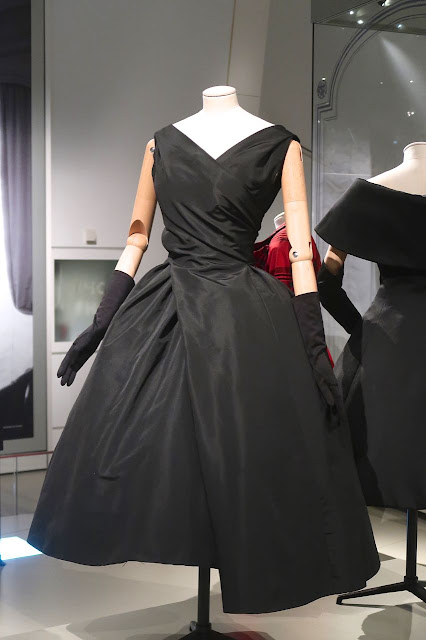In celebration of the House of Dior’s 70th anniversary, the Royal Ontario Museum has created a stunning retrospective of the early years of Christian Dior haute couture, 1947 to 1957. Exploring the brilliance behind Dior’s dramatic creations that revived the Paris haute couture industry after the devastation of the Second World War, the exhibition offers captivating insights into the creative process and mechanics of the fashion industry in Paris during a pivotal time. Presented by Holt Renfrew, the exhibition draws from the ROM’s permanent collection of textiles and fashions, this treasured collection is arranged thematically by Daytime - coats, suits, and day dresses - Late Afternoon to Evening - cocktails and dinner dresses - and Evening - ball and formal gowns. The pieces are contextualized with Dior accessories and perfumes, and augmented by contemporary film, sketches, fashion photographs, and advertisements. Many of the pieces were worn in Canada and donated by socialites of the period from Montreal and Toronto. In addition to the ROM’s own collection, the exhibition is enhanced by loans from Christian Dior Héritage; Paris and Maison Hurel, Paris; Musée d’Art et d’Industrie de Saint-Etienne; Bata Shoe Museum, Toronto, and several other lenders. Visitors will discover how and why the designer’s iconic lines, luxury textiles, and romantic embroideries laid the foundation for the House of Dior’s global success.
Christian Dior
Born in 1905 in Granville, France, Christian Dior began his career in Paris as a freelance designer and sketch artist, selling fashion illustrations to magazines in 1935. His first job in an haute couture house was in 1938 when Robert Piguet hired him as modéliste. In 1941, Christian Dior joined the house of Lucien Lelong as assistant designer and in 1946 he set up his own couture house. On February 12, 1947, Christian Dior presented his first collection, that became known as the “New Look.” The soft shoulders, cinched waist, accentuated hips and long, full skirts of Christian Dior’s masterful cuts swept away the wartime masculine silhouette and launched a fashion revolution that influenced women’s fashions throughout the 1950s and has kept the House of Dior a fashion leader to this day.
"All around us, life was beginning anew; it was time for a new trend for fashion."
- Christian Dior, 1956 -
fitted waist, and rounded shoulders
Christian Dior Exhibition at the ROM
Lady looking longingly at Dior dresses - how fashion has changed
Delphine cocktail dress, Ligne Aimant, 1956 Autumn-Winter collection
Spectacular Venezuela Dress, Fall/Winter 1957
Caracas, Libre, 1957 Spring-Summer
Sophia Loren wearing Dior Caracas dress in black
'Zemire' cocktail dress 1955
Christian Dior’s daytime suits and dresses were deigned for women on the move; he made sure the Dior woman looked sleek and feminine, and was not hindered by her clothing
Auteuil two-pice day suit from the Spring/Summer 1949 collection
"For day-time in town, a dark suit in a smooth material is best...the little black suit cannot be beaten for elegance and usefulness" - Christian Dior 1955
Custom designed labels by Holt Renfrew for the Dior Fashions they sold through the store
Day dress from 1955 with handprinted 'Bambou' fabric by Staron with coordinating gloves
Sharon printing register from May 1955 recorded the names and firms commissioned to create the designs
Custom printed 'Bambou' fabric by Staron for Christian Dior, required nine silk screens to create the look
Christian Dior with model Dorothy Emms, 1952
Staron was one of the oldest and most prominent luxury textile and ribbon-mauficaturing firms in France, and were a key supplier of textiles to the House of Dior. "Textile salesmen are extraordinary magicians who dazzle you with...a fan...a pyrotechnic display of colour."
The Evening Gown collection at the exhibition
Rose France Grand Gala Gown Autumn-Winter 1947-48
Palmyre evening dress from the 'Profilee' collection Autumn-Winter 1952
Detail of the above dress made of a sugared almond blue Celanese satin, stylized with floral motifs reminiscent of those found in Islamic art, and embroidered with silver and gold threads, gemstones, pearls and Swarovski crystals
Touch screen monitors around the exhibit provide additional images about each dress,
like this original sketch for the 'Isabelle'
The Isabelle evening dress Spring-Summer 1948
The Isabelle from the back — gorgeous
Tour Eiffel gold jacket, 1949 Spring-Summer, made of silk satin lined with cotton lace
Dior handbag with secret drawer for jewelry when travelling, iconic long gloves and Miss Dior perfume , named after Christian’s sister, was the first perfume I ever owned
Handwritten booklet cataloging fabrics and fashions from the House of Dior
Custom designed shoes with coordinating fabrics with Dior fashions
Magazines from the 1950s featuring Christian Dior
'Maintenon' necklace by Henkel & Grosse for Christian Dior for Spring-Summer 1956.
made of multi-coloured glass tones, pastes and metal, on loan from Dior Héritage, Paris
Lily of the Valley necklace was made for the House of Dior in 1950 by the legendary Maison Gripoix, which also designed costume jewellery for Chanel, Balenciaga and later Yves St. Laurent and Christian Lacroix; on loan Carole Tanenbaum
Miss Dior Eau de Toilette - highly superstitious, Christian Dior loved the lily-of-the-valley, a symbol of happiness that heralded the arrival of spring and the haute couture
Dior considered perfume the ‘finishing touch of a dress’
Rene Gruau 1950s Linen backed Christian Dior Perfume Ad, print
Christian Dior ad campaign, c.1950
Ghislaine Arsac in Dior, 1956
'Dovima with Elephants' by Avedon August 1955












































No comments:
Post a Comment